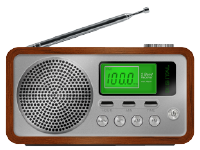|
The time for one cycle is called the period. The graph below shows position versus time for a mass oscillating up and down on a spring. Notice that one complete cycle occurs from 7 to 14 s; if we start counting the cycle at 7 s, the mass returns to the same position at 14 s. This graph is typical of simple harmonic motion. By simple we mean that there is a single period (or single frequency) that describes the motion. 
|

|
The frequency of an oscillator tells you the number of cycles it completes each second. You experience a wide range of frequencies in your environment. A human heartbeat might have a frequency of ⅔ cycle per second when you first awake in the morning, 1–1.5 cycles per second for your normal activity, and 2–3 cycles per second when you are exercising. A plucked rubber band might have a frequency of 50 cycles per second. The sound of the musical note “A” has a frequency of 440 cycles per second. 
|
The unit of frequency is called the hertz (Hz), where one hertz corresponds to one cycle per second. A frequency of 440 cycles per second is usually written as 440 hertz, or abbreviated 440 Hz. The hertz is a unit that is the same in English and metric measurement systems. 
 |
 When you tune into a station at 101 on the FM dial, you are setting the oscillator in your radio to a frequency of 101 megahertz (abbreviated MHz), which is an incredibly rapid 101,000,000 cycles per second. The acronym FM stands for frequency modulation and the frequencies of the musical sound you hear from the radio are transmitted through the air by the radio transmitter tower on a carrier frequency of 101 MHz. You hear music when the oscillator in your radio is exactly matched to the frequency of the oscillator at the radio station. The electronics in the radio receiver subtracts out the carrier frequency, leaving the music as a remainder.
When you tune into a station at 101 on the FM dial, you are setting the oscillator in your radio to a frequency of 101 megahertz (abbreviated MHz), which is an incredibly rapid 101,000,000 cycles per second. The acronym FM stands for frequency modulation and the frequencies of the musical sound you hear from the radio are transmitted through the air by the radio transmitter tower on a carrier frequency of 101 MHz. You hear music when the oscillator in your radio is exactly matched to the frequency of the oscillator at the radio station. The electronics in the radio receiver subtracts out the carrier frequency, leaving the music as a remainder. 
|
Frequency and period are the inverse of each other and are related by equation (14.1). A swing with a period of 2.5 s has a frequency of 1 ÷ 2.5 = 0.4 Hz. Large oscillators (such as a swing) tend to have low frequencies. Small or stiff oscillators (such as a guitar string) tend to have higher frequencies. 
|
| (14.1) | | | f | = | frequency (Hz) | | T | = | period (s) |
| Frequency and period
|
|
A sprinter’s heart beats once every 0.33 s. What is the frequency of her heartbeat? | Asked: | frequency f of the heart beat | | Given: | period of beating heart, T = 0.33 s | | Relationships: | f = 1/T | | Solution: | Use the relationship between period and frequency: | | Answer: | The frequency is 3.0 Hz. | 
|
The swing of a woodcutter’s axe takes 5 s. What is the frequency of his movement? - 0.2 Hz
- 0.5 Hz
- 5 Hz
- 25 Hz
 |
This movement has a period of 5 s. The frequency is the inverse of the period: 
|

